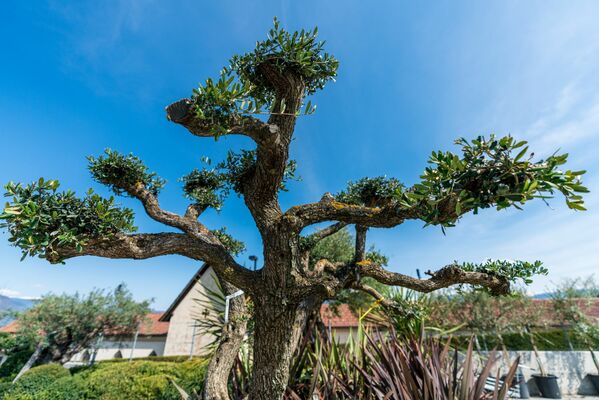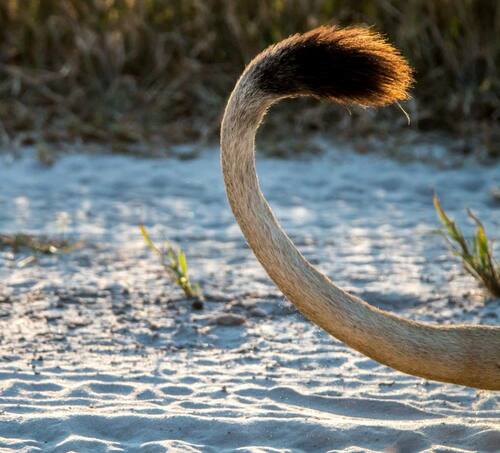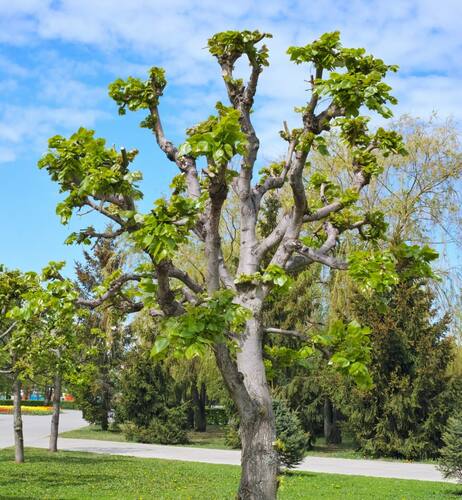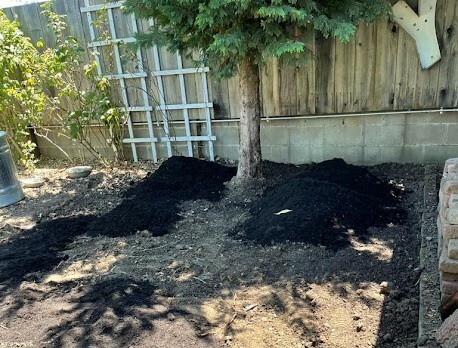The Risks of Lion's Tailing: Essential Tree Pruning Insights

Introduction
When it comes to tree care and maintenance, it's essential to understand the dos and don'ts. One common but harmful practice that we encounter is "lion's tailing." It's a form of over-pruning that involves removing a large number of inner branches, leaving the tree's limbs looking like a lion's tail. In this article, we'll explore what lion's tailing is, why it's wrong, its detrimental effects, and what can be done to rectify it. We'll also provide tips on how to communicate effectively with tree care professionals to ensure the health and beauty of your trees.
What is Lion's Tailing?

A Lion's Tail, the Namesake of Lion's Tail Pruning
Lion's tailing, often referred to as the "gutting" of a tree, is a pruning technique where a substantial portion of the inner branches is removed. This practice results in the tree's limbs appearing long and slender, with a puff of foliage only at the end, resembling the tuft on the end of a lion's tail. While lion's tailing may not be as visually disturbing as topping (the process of removing the whole tops of trees), it can still have significant negative consequences on a tree's health and appearance.
The Importance of Well-Spaced Inner Lateral Branches
Lion-tailing is a common form of over-pruning. It is very important to maintain well-spaced inner lateral branches when it comes to pruning your trees. Even distribution of foliage along any given branch is absolutely necessary and is very important. Lion-tailing occurs when a tree is essentially stripped of most or all of its interior branches and foliage, leaving only a minimal amount of growth at the end of the branch.
The Hazards of Lion's Tailing
Lion's tailing not only impacts a tree's aesthetics but also poses potential hazards. As all of the weight is concentrated on the ends of the branches, the majority of the new growth is added on these bushy ends. If a tree’s branching structure does not support evenly distributed weight, much more stress is placed on the branch, allowing more breakage to occur.
Often, lion's tailing results in the removal of as much as 50 to 75 percent of the tree's foliage. This practice is regrettably becoming increasingly common, leading to unhealthy and structurally weakened trees. Trees need leaves to thrive, as leaves are essential for photosynthesis, the process that converts sunlight into food for the tree. If it looks unnatural or over-thinned, it probably is.
Effects of Lion's Tailing

A Tree with "Lion's Tail" Tufts at the End of Each Branch
Lion's tailing can have several adverse effects on trees, including:
- End-Heavy Branches: The excessive weight at the branch ends can lead to instability, making the tree more prone to tipping or breakage.
- Branch Failure and Breakage: Weakened branches are more likely to fail, especially during strong winds, heavy snow, or ice events.
- Sun Scalding: The sudden exposure of previously shaded branches to direct sunlight can lead to sun scalding, causing damage to the tree's bark.
- Rapid Sucker Growth: The tree may respond to lion's tailing by producing rapid sucker growth, which can further weaken the tree's structure.
- Rotting and Cracks: With less foliage, branches may become more susceptible to rot and develop cracks.
- Increased Disease and Insect Vulnerability: Weakened trees are more susceptible to diseases and insect infestations.
- Severe Stress: Lion's tailing places the tree under severe stress, affecting its overall health and longevity.
Why is Lion's Tailing Wrong?
Several reasons make lion's tailing a detrimental practice:
- Reduced Food Supply: Removing a significant percentage of leaves used for photosynthesis diminishes the tree's food supply, weakening it over time.
- Epicormic Sprouting: Over-pruning often triggers a stress reaction called epicormic sprouting, resulting in the growth of clusters of branches along the trunk and limbs. This leads to weak branch unions and a poorly structured tree.
- Susceptibility to Environmental Conditions: Long, leafless branches become vulnerable to breakage and splitting when exposed to wind, snow, or ice events.
What Can Be Done to Rectify Lion's Tailing?
The good news is that a tree can recover from lion's tailing if the right steps are taken. It's crucial to allow the sprouts that emerge to develop into branches. Once they've matured, slightly reduce and space them along the branch to encourage a healthier structure.
It's important to emphasize that proper pruning techniques are vital in tree care. Pruning styles like "hat-racking" (topping), "over-lifting" (removal of too many bottom branches), and lion's tailing (gutting) are widely considered malpractice in arboriculture. Good pruning is an art, with the finished result being subtle and natural-looking. The pruning work should be understated and ideally go unnoticed at first glance.
Effective Communication with Tree Care Professionals
To ensure that your trees receive the best possible care, effective communication with the tree care professionals you hire is essential.
Clearly Define Your Expectations
Outline in writing what you want and what you do not want in terms of tree pruning. Never assume that the hired worker instinctively knows your preferences, even if they are a certified arborist. Misunderstandings can and do occur.
Consult with the Professionals
Trust the professionals at Arborist Now to review their plan of action for pruning your trees. Ensure that your questions and concerns are addressed to your satisfaction. Schedule an appointment with Arborist Now today for expert tree care.
The Environmental Benefits of Proper Tree Care

A Backyard Filled with Healthy Trees
Maintaining the health and beauty of your trees goes beyond aesthetics and safety. Proper tree care contributes to numerous environmental benefits, which are increasingly important in today's world.
Here are some of the positive impacts of healthy trees on the environment:
Improved Air Quality
Trees play a critical role in filtering and purifying the air. Through photosynthesis, they absorb carbon dioxide and release oxygen. Additionally, trees can capture harmful pollutants from the air, such as sulfur dioxide and nitrogen oxides, thus improving air quality in urban areas.
Biodiversity Support
Trees provide habitats and food for a wide range of wildlife, from birds and insects to mammals and fungi. Healthy trees create a diverse ecosystem that supports biodiversity and contributes to the overall health of the environment.
Erosion Control
The root systems of trees help stabilize soil and prevent erosion. This is especially important in areas prone to landslides and flooding. Healthy trees can play a vital role in protecting against soil erosion and preserving natural landscapes.
The Economic Value of Trees

A Backyard Shaded by a Healthy Tree
In addition to their environmental benefits, trees also have significant economic value. Trees can enhance property values and reduce energy costs, among other advantages.
Here's a closer look at the economic benefits of trees:
Increased Property Values
Properties with well-maintained trees tend to have higher values. Trees provide shade, beauty, and a sense of tranquility that attracts homebuyers and enhances the desirability of a neighborhood.
Energy Savings
Strategically planted trees can provide shade in the summer, reducing the need for air conditioning. During the winter, they can act as windbreaks, reducing heating costs. These energy-saving benefits can translate into lower utility bills for homeowners.
Reduced Stormwater Management Costs
Healthy trees help manage stormwater runoff by absorbing and filtering rainwater. This reduces the burden on municipal stormwater systems and can result in cost savings for cities and communities.
Increased Business Revenue
Trees can make commercial areas more attractive to customers. Businesses located in tree-lined streets or surrounded by greenery often experience higher foot traffic and, consequently, increased revenue.
Tree Preservation and Sustainability
Preserving trees and maintaining their health is crucial for sustainability. Sustainable practices ensure that trees can continue to thrive, benefiting the environment and society.
Here are some key principles of tree preservation and sustainability:
Proper Pruning Techniques
Avoid harmful practices like lion's tailing, topping, and over-lifting. Instead, opt for proper pruning techniques that promote tree health and vitality. Regular pruning to remove dead or diseased branches and maintain proper branch structure is essential.
Mulching

Mulch Being Spread At the Base of a Backyard Tree
Mulching around the base of a tree helps retain moisture, regulate soil temperature, and suppress weeds. This not only benefits the tree but also reduces the need for herbicides and conserves water.
Soil Care
Healthy soil is the foundation for healthy trees. Soil aeration and organic matter addition can improve soil quality, promoting optimal root growth and nutrient absorption.
Pest and Disease Management
Regular inspections and timely interventions are essential to prevent and manage pest infestations and diseases. A healthy tree is more resilient against these threats.
Tree Planting
Adding new trees to your landscape contributes to the sustainability of your local environment. Choose native species that are well-suited to your area to maximize their long-term benefits.
Conclusion
In the world of tree care, lion's tailing is a practice that should be avoided at all costs. Not only does it compromise the health and appearance of your trees, but it also introduces potential hazards and vulnerabilities. To ensure the well-being of your trees, it's crucial to adhere to proper pruning techniques and communicate effectively with tree care professionals. Choose a trusted partner like Arborist Now to keep your trees thriving and beautiful for years to come. Don't let your trees become victims of lion's tailing—leave gutting for fish, not for trees. By practicing proper tree care and embracing sustainability, you can enjoy the myriad benefits that trees bring to the environment and your community.
We may receive affiliate compensation for some of the links below at no cost to you if you decide to make a purchase.
Originally posted on December 16, 2016






